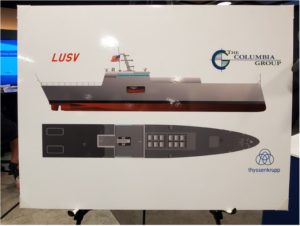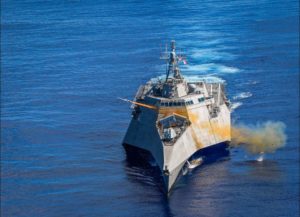The Navy issued a Request for Proposals (RFP) on May 22 for Combat System (CS) Ship Integration and Test (SI&T) for Littoral Combat Ships (LCS) and Large Unmanned Surface Vehicles (LUSV).
The LCS and LUSV combined are under the Small Surface Combatant program. The RFP, posted to beta.sam.gov, said the offered work covers fiscal years 2021 to 2031 and covers lethality and survivability upgrades to both the Freedom and Independence-variant of the LCS after ship delivery and all combat systems integration on the LUSV before and after vessel delivery.

In the solicitations, the Navy explained SSC CS SI&T covers seven types of work over 21 contract line item numbers. This includes providing program management, planning, training, and other efforts to effectively support the execution of CS SI&T; development, assessment, modification, and update of CS-related Test Procedures, CS Master Test Plan, and CS Test Sequence Network; review, development, assessment, modification, and update of CS Space Arrangement drawings, CS Installation Control Drawings and CS Interface Control Drawings including end-to-end CS Interface Control Drawings; performance of CS Ship Integration and Test Planning; performance of Waterfront Integration and Test of the CS and Combat System Support Equipment at the system and subsystem levels; providing support to Government Test Teams in conducting the CS Ship Test and Trials Program; and engineering studies to include feasibility studies as tasked by the Government for CS improvements.
During the Surface Navy Association Symposium in January, a Navy official said the service was starting a two-phase LCS lethality and survivability program to improve the capabilities of the two variants (Defense Daily, Jan. 14).
This includes improving the gun weapon system with an improved fire control system, upgrading the Surface Electronic Warfare Improvement program (SEWIP) , improved decoys, upgrading to a COMBATSS-21-based combat management system to be common across both LCS variants, continuing deployment of the Naval Strike Missile to the ships, and upgrading to digital radar.
The official, LCS Integrated Combat Systems (ICS) Deputy Program Manager Kitty Sutherland said her team was working with the LCS Fleet Introduction and Sustainment program team to guarantee improvements are installed by FY ’23.

The RFP documents also explained the contract will provide support to remote operations of the LUSV Block (BLK) 1 and Block 2 Integrated Combat System (ICS).
“The LUSV ICS remote operations will be performed using a land-based system intended to represent the tactical Autonomous Vessel Operations Center for the LUSV BLK 1 and BLK 2 vessels. The tactical Autonomous Vessel Operations Center is intended to provide multiple control aspects of the LUSV Vessel,” the Navy said.
Earlier this year, the Navy’s FY 2021 budget request documents outlined the LUSV acquisition plan, which was pushed back compared to the service’s previous plans (Defense Daily, Feb. 14).
The Navy expects to award the conceptual design contracts for LUSV to multiple vendors in the fourth quarter of FY 2020 and award the detail design and construction contract to a single vendor for the full LUSV in FY ’22.
In FY ’23, the Navy plans to act on contract options to produce additional LUSVs with the ICS and Vertical Launch System (VLS) and transition LUSV to a program of record. Congress barred integration of the missile tubes so soon in the FY 2020 budget bill, arguing it is too early to the need.
The Navy now plans to transition LUSV to a program of record in FY ’23 when it shifts it to the main shipbuilding account.
The service plans to procure 10 LUSCs over the next five years consisting of two more Overlord prototypes, one LUSV prototype via research and development funds, two LUSVs with the ICS and VLS each in FY ’23-’24, and three vessels in FY ’25.
The Navy aims for the later LUSVs to have the ICS and various payloads to support anti-surface warfare and strike missions.